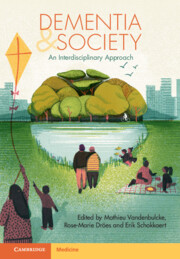Book contents
- Dementia and Society
- Dementia and Society
- Copyright page
- Contents
- Contributors
- Additional material
- Preface
- Chapter 1 Different Perspectives on Dementia
- Chapter 2 From History to Intervention
- Chapter 3 Personhood, Identity and Autonomy
- Chapter 4 Living Meaningfully with Dementia
- Chapter 5 Quality of Life of Persons with Dementia
- Chapter 6 Living with Dementia
- Chapter 7 Informal Care for Persons with Dementia
- Chapter 8 Risk Factors and Non-Pharmacological Prevention of Dementia
- Chapter 9 An Empowering Dementia Environment
- Chapter 10 The Impact of the COVID-19 Pandemic on the Well-Being of People Living with Dementia
- Chapter 11 Care Planning and the Lived Experience of Dementia
- Chapter 12 Societal and Ethical Views on End-of-Life Decisions in Dementia
- Chapter 13 Driving and Dementia
- Chapter 14 Social and Private Costs of Dementia
- Index
- References
Chapter 9 - An Empowering Dementia Environment
Published online by Cambridge University Press: 26 May 2022
- Dementia and Society
- Dementia and Society
- Copyright page
- Contents
- Contributors
- Additional material
- Preface
- Chapter 1 Different Perspectives on Dementia
- Chapter 2 From History to Intervention
- Chapter 3 Personhood, Identity and Autonomy
- Chapter 4 Living Meaningfully with Dementia
- Chapter 5 Quality of Life of Persons with Dementia
- Chapter 6 Living with Dementia
- Chapter 7 Informal Care for Persons with Dementia
- Chapter 8 Risk Factors and Non-Pharmacological Prevention of Dementia
- Chapter 9 An Empowering Dementia Environment
- Chapter 10 The Impact of the COVID-19 Pandemic on the Well-Being of People Living with Dementia
- Chapter 11 Care Planning and the Lived Experience of Dementia
- Chapter 12 Societal and Ethical Views on End-of-Life Decisions in Dementia
- Chapter 13 Driving and Dementia
- Chapter 14 Social and Private Costs of Dementia
- Index
- References
Summary
A beneficial environment is of utmost importance for the well-being of people with dementia. This environment comprises different aspects and levels. We start the chapter with a discussion on the importance of relationship-centred care, as a more holistic alternative to person-centred care. One way to put this concept into practice, is by using the ‘Senses Framework’. We continue with a description of how architecture can be favourable for people with dementia by taking them into account as social beings within their cultural context. In this way architecture is more about creating a proper environment for continuing daily activities and social interaction. We subsequently elaborate on dementia-friendly communities, where persons with dementia can navigate, feel safe and maintain their social networks. Singapore is used as a case study. Importantly, technology and the “virtual” environment is taking up more and more place in our existence, and expands our natural environment. This provides us with a whole new range of possibilities for assessment and assistance in dementia. We conclude with the example of nighttime agitation, where different aspects of the social and physical environment (architecture, care, technology) interrelate with this core symptom of dementia.
Keywords
- Type
- Chapter
- Information
- Dementia and Society , pp. 167 - 192Publisher: Cambridge University PressPrint publication year: 2022



